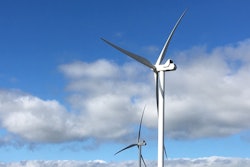
In keeping with the Betz limit, wind turbines can’t harness more than 59% of the wind’s kinetic energy. If a wind turbine was 100% efficient, there would be no wind left to turn the blades.
To increase electrical generation and get as close as possible to that 59% limit, wind turbines rely on yaw drives to point the blades in the direction of the wind. Even with the drives, however, utility-sized wind turbines only get to within 75% to 80% of the Betz limit.
QED Wind Power manufactures the Phoenix 20-kW wind turbines which generate up 50,000 kw-hr annually (assuming a 20-knot wind), enough to power a mid-sized farm or up to eight homes.
Yaw drives from Gearing Solutions, which keep the blades turned into the wind, are a critical factor in keeping QED’s turbines turning and making as much electricity as they can.
When QED began looking into redesigning its 20 kW turbine, the components were all made in China. The team wanted American-made parts to ensure quality control and better access to repair parts.
QED got its wish, and the Phoenix is a veritable tour of American manufacturing: blades from Texas, meteorological sensors from Oregon, and the yaw drive from Gearing Solutions in Ohio.
QED talked with several yaw drive suppliers before choosing Gearing Solutions, but they wanted to sell the team off-the-shelf products which could not take full advantage of the design or supply their specific needs.
The engineering staff at Gearing Solutions talked with QED several times before coming up with a custom prototype that would meet its needs.
The prototype had a stronger, more durable shaft and could use a three-phase 1.5-hp motor as the drive motor. The drive was also designed to use grease discs rather than gear oil to simplify maintenance. After several months of testing and revisions in shaft size and material, the new yaw drive was ready.
It combines roller-gear technology with innovative gear construction to optimize the gearbox and minimize size. It is 50% shorter than standard gearboxes and can handle over 30 hp.
With the addition of an internal roller gear, driver, and several planetary gears, the new drive handles loads more than three times the size of the earlier drive, and aluminum housings make the drive 50% lighter, lowering the weight-to-torque ratio and increasing the power-to-weight ratio. The lower weight simplifies installation and repairs—both critical when working at height in a tight space. The smaller size also lets the turbine’s nacelle be lighter and more aerodynamic.
Despite their lighter weight, the yaw drives are still durable enough to provide years of trouble-free service.
Many have been in continued service for more than five years with no downtime.























